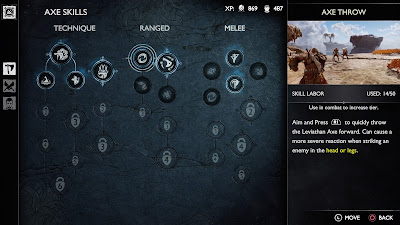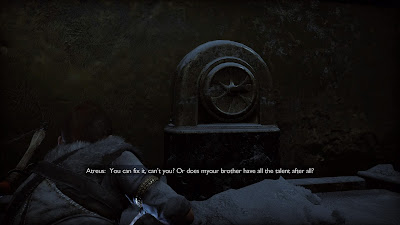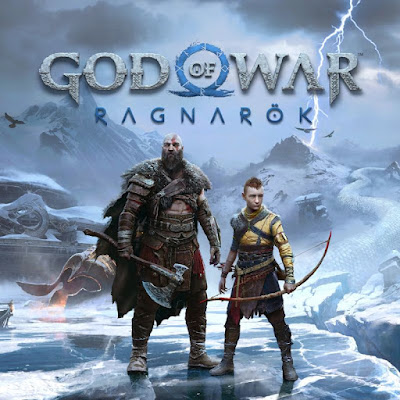Note: This review contains spoilers for God of War (2018).
After God of War: Ascension milked the God of War series’ Greek mythology roots for all it was worth, the franchise went in a new direction and began exploring the realm of Norse mythology, seemingly inspired by creator David Jaffe’s original vision for God of War III, starting with God of War (2018). While this new chapter in the franchise was initially planned for at least three games, the increased development time and cost for AAA games led the Norse Era to be capped off at two games, concluding with God of War: Ragnarök (Ragnarök) in 2022. While I did not play this game at launch, I did play the PS5 version as soon as I could when I got it as a gift, as the game was high on my radar once it came out. While Ragnarök is an overall fantastic conclusion to the Norse Era that was worth the wait, the experience was still affected by the amount of content and some technical issues.
Years after the start of Fimbulwinter, Kratos and Atreus are on the run from Freya, who seeks revenge for the death of her son Baldur. Once they make it back to safety, Kratos wants to continue their training, but Atreus desires to learn more about Loki, his other identity. After reluctantly giving Atreus time to bury their wolf Fenrir, Kratos goes out to search for his son, during which Loki’s abilities begin to manifest. Once they get back home, Kratos and Atreus are visited by Thor and Odin, who try to make a deal for a peace treaty. When Kratos refuses Odin’s terms, Thor is free to fight him in revenge for the deaths of his sons Magni and Modi.
The plot of Ragnarök feels like a natural extension of the previous game, giving players a more in-depth look at the series’ take on Norse mythology, while also tactfully exploring themes of parenthood, generational trauma, fate and revenge in a way that directly serve the story and the development of several characters. Of particular note is the game’s depiction of Odin, who is presented as a lying, manipulative god who will stoop to any low for his own benefit and sees everyone, even members of his own family, only in terms of value to achieving his goal. Whereas the previous game was a bit more conservative with referencing the Greek games for story reasons, Ragnarök makes more direct references to said games, especially the events of God of War II, in ways that contribute to character development and tie in with the heavy fate theme. On a more humorous note, the more direct ties to the Greek Era also sees the return of the boat captain running gag, albeit very subtly.
That said, while the circumstances behind it are understandable, the plot feels like two games’ worth of content put together, resulting in some dragging points. Not helping is that the cutscenes are (currently) unskippable, which is reasonable on a first playthrough but can be a turnoff for some on subsequent playthroughs. Additionally, it should be noted that while the Valkyrie sidequest in the previous game is entirely optional, it has some story significance here, so newer players should either see how far they can get in said quest or otherwise brush up on the details in some way. It is also worth noting that the start menu includes a recap of the 2018 game, presumably to serve as a reminder for returning players or to catch newcomers up to speed, however it’s not really too informative and only provides some short story highlights without much context.
Before I talk about the gameplay, I should mention that the game updated once, specifically to Ver. 3.002.000, during my initial playthrough. Though this was simply a performance update, I am not entirely sure how much this affected my experience.
The core gameplay is similar to that of the previous God of War title, but with some differences to enhance the experience. To start with, the game provides a more expansive array of accessibility features, one of which is a screen reader for the visually impaired. If you want to save your thumbs, two features I would recommend turning on are Auto-Pickup, since there’s no real reason not to pick up anything and it knows when not to pick up Health/Ragestones by default; and Traversal Assist, as it can cut down the number of steps needed to travel between immediate areas. The PS5 version also takes advantage of the haptic feedback and localized rumble provided by the DualSense for greater immersion, though not quite to the same extent as Ratchet & Clank: Rift Apart. Additionally, certain actions can be mapped to swipes of the touch pad for increased flexibility, which I used to map Quick Turn to a down swipe.
 |
| There's no real reason not to turn this on. |
In addition, the combat has been updated to allow for greater variety without feeling forced. Similarly to God of War III, different enemy types require a different weapon to deal with them more efficiently, with color-coded Burn enemies taking more damage form the axe and Frost enemies the Blades of Chaos. As an extension of this, some enemies have a layer of Frost health that must be burned away by the Blades before dealing damage and vice-versa for the axe extinguishing Burn health, plus you can hold Triangle to charge the axe to deal Frost damage and the Blades for burn damage. Additionally, parts of the environment such as trees and boulders can be used to your advantage to deal with crowd control while Alfheim offers a new option for the axe in which you can bounce it off Twilight Stone to attack enemies or solve puzzles. Thanks to them being available at the start, the Blades of Chaos have been further implemented into gameplay, allowing for increased puzzle-solving and traversal options at designated points, with even further traversal and combat options being opened up by a spear you obtain later in the main campaign. There is also a much greater amount of enemy variety than before, with the infamous recycled Troll enemy type in the previous game being relegated to optional side bosses.
Combat indicators have also been made more prominent to make them easier to register, with a yellow circle still indicating a block break and a red circle meaning an unblockable attack, as well as a new double blue circle indicator that indicates the attack can be stopped by the new Shield Strike mechanic. A new mechanic known as Death From Above has also been added, in which you sprint off a ledge and then attack to catch enemies unawares or increase your attack power on enemies at a lower elevation. An ability of the Cod of War armor in the previous game’s New Game+, in which Healthstones generate a damaging shockwave when picked up, has also been made into a feature, enabling one to freely weaponize healing in the midst of combat. Additionally, if Kratos is at critical health, there is some minor health regen that lasts just long enough to bring him out of the critical state.
In addition to
the weapons, shields have been given increased versatility, with a fewer number
of shields that each have their own unique abilities rather than being a solely
aesthetic change, as well as the option to augment them further with Rönds for
additional gameplay effects. While the armor system is similar to the original
release, you now have the ability to compare armor sets and preview future
upgrades to influence purchasing decisions, plus wrist and waist armor have
effects that become stronger when matched up. As a side note, you can alter the
appearance of some armor pieces among other armor pieces you own, though I didn’t
explore this feature that deeply.
The Enchantment system has also been overhauled. Rather than equipping them to armor pieces and having to keep swapping them each time you change your build, you obtain an item known as the Amulet of Yggdrasil that can be upgraded to carry up to nine Enchantments at once, with many of them being parts of a Realm-based set that become stronger when you have up to three from the same set equipped. While the exact build one works with can vary by the player, the one I went with included nothing but Enchantments that worked on their own, each one providing some sort of protection or combat boost. Talismans return in the form of Relics, which have no Enchantment slots but are mechanically similar in that they provide a temporary effect to combat or, in one case, cannot be upgraded and exists mainly to initiate combat as part of a side quest.
The Skill system returns from the previous game, with a menu that’s easier to navigate as well as further incentivize using the Skills you buy through Skill Labors, which when completed unlock the ability to augment them further with Mod Tokens. Fortunately, for those actively seeking to unlock said Mod Tokens, there is an endless arena in Niflheim that is useful for grinding Skills, though you won’t gain any XP for it. Spartan Rage has been given an upgrade as well, in that it can now be upgraded and has three different types to choose from: Fury is the standard Spartan Rage, Valor provides a health boost and Wrath launches a powerful attack with your current weapon. There is also now more of a reason to hunt down and kill Odin’s ravens, as killing enough of them allows you to open chests in Niflheim and killing all of them unlocks a boss battle. As an additional surprise, the original Health/Rage system returns from God of War III, where you can increase the length of the meters by finding the corresponding items in chests hidden around the Realms, with Iðunn Apples increasing Health and Horns of Blood Mead increasing Rage; due to a lack of a Magic meter, there is no Phoenix Feather equivalent.
 |
| The overhauled Skill Tree is easier to navigate. |
Atreus plays a similar role during gameplay that he did in the previous installment, but now with access to two new arrow types: Sonic, which can break specific objects with a green glow and deal sonic damage to enemies; and Sigil, which cancels immunities to physical attacks and can be combined with the axe and Blades for solving environmental puzzles. New to this game, he is also now playable in some sections of the story, with similar gameplay to Kratos but centered more around the bow and arrow with another character often backing him up. Certain interactions also take into account that he is physically weaker than Kratos, meaning he also has more restricted access to different areas of each Realm as a result. I will also mention here that his sections of the story are where the plot tends to drag a bit, as they involve a lot more walking and talking when compared with Kratos.
In addition to being able to visit all nine Realms throughout the course of the game, some of them have extra areas accessible after completing their main storylines, with these areas having a more open design with various side quests and bonus objectives with various rewards, among them armor sets, Enchantments, Runic attacks and Apples/Horns. That said, the size of each of these areas varies depending on the Realm, with some feeling more manageable than others. In this regard, Vanaheim is easily the worst offender, as the main part of the Realm already feels a little unwieldy in terms of design, only to be outclassed by the overwhelmingly-large bonus area that features quite a number of side quests, even with the gateways offering fast travel. Somewhat related, the overall level design throughout the game feels held back by the limitations of the PS4 version, with some slow-moving transports and the return of the Realm Between Realms’ design to disguise loading, as well as some visible texture pop-in, which can feel a bit odd when playing the PS5 version.
Aside from pacing issues brought on by the technical limitations of a last-gen system, other technical issues popped up during my initial playthrough. A more minor one occurs when viewing lore pickups in the pause menu when prompted, where they can show up blank, though this can be resolved by backing out, switching to another category and then returning to the one with the lore you collected. A more major bug is that it is possible to become softlocked in an area, which can be corrected by loading a previous autosave or reloading the checkpoint. Incidentally, this seemed to occur a little more following the aforementioned update, though only sparingly. Though probably more of a nitpick, it is worth mentioning that, unlike some other PS5 games I’ve played, pressing the “Resume Activity” option in the Game Hub on the PS5 menu doesn’t bypass the main menu of the game itself to make getting back into it faster, instead bringing you back to the title screen and defeating the purpose of said option.
Visually, the graphics have been improved greatly from the 2018 game, with special mention to environmental detailing and the starting, more weathered look on the Blades of Chaos that appear more cleaned up the more you upgrade them. The gameplay UI has been updated as well, making it easier to read while still retaining some familiarity with the previous game. There was, however, a point in the late game where I had the compass disappear on me even after trying to escape an encounter, which was resolved by closing the game and then reloading a save. As far as the text goes, the default text size is far more legible than it was before, plus you can preview any changes you make and the text size differences are far more noticeable. While the subtitles themselves are good, I did notice a single spelling error, which bothered me greatly in the moment.
 |
| The offending error, for those who are curious ("myour" instead of "your"). |
One highlight is the voice acting, with Christopher Judge putting even more emotion into his performance as Kratos and other returning voice actors putting in even greater performances than in the first game. Richard Schiff of The West Wing fame turned out to be a fantastic pick for the role of Odin, portraying an interesting take on the character as a smooth talker that makes him intimidating in his own way, especially in his first appearance, that contributes to his personality as a notorious liar. Ryan Hurst is also good as Thor, making his suppressed contempt and alcoholic nature clear in his voice, with some room for a more “human” side to him. Being a fan of his YouTube content under the name ProZD, it was a little weird at first hearing SungWon Cho as the voice of Ratatoskr, but I found him to be great in the role, especially since he manages to make the character and each of his spectral forms sound unique, with the exception of Troy Baker returning as the voice of Bitter. Another thing worth mentioning is that some audio is split between the TV and controller speakers, increasing a sense of immersion alongside the haptic feedback.
While the voice acting is good, one particular annoyance is that, if you take more than five seconds to solve a puzzle or simply don’t do it right the first time, the characters will outright tell you the solution instead of simply nudging you, leading me to oftentimes have to rush to figure out the solution before the characters tell me what to do, with mixed results. It got so bad that it ended up reminding me of how Blinx 2 outright tells you the solution to a puzzle right before you do it. As a minor nitpick, while the music is generally in line with the previous game, I felt that there was a missed opportunity to incorporate the track “Rage of Sparta” into the final boss fight.
Despite its rough edges, God of War: Ragnarök is an overall fitting conclusion to the Norse Era, thanks to some fantastic storytelling that neatly wraps up multiple character arcs and greatly improved gameplay. As it has been heavily teased for the last two games, I am very interested in seeing what they might do when exploring Egyptian mythology.


No comments:
Post a Comment